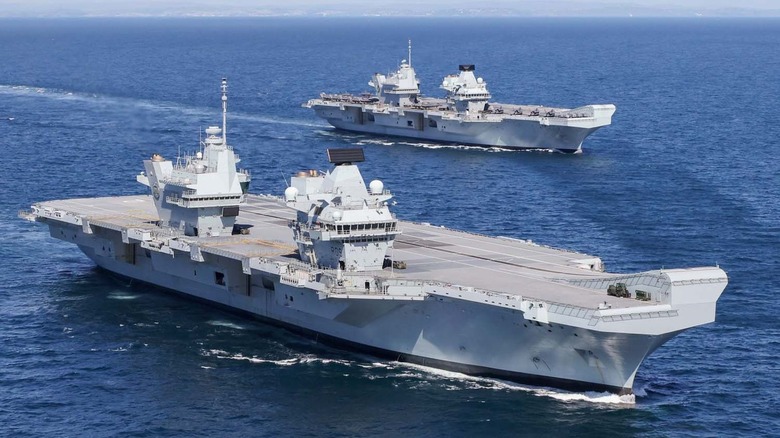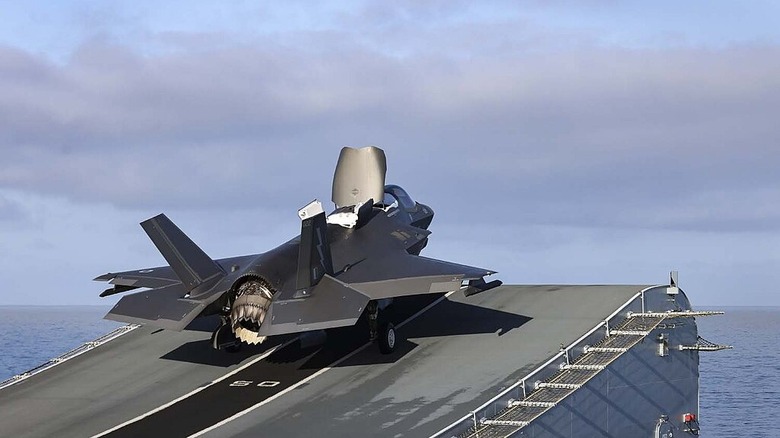How Many Fighter Jets Can A UK Aircraft Carrier Hold?
The United Kingdom's Royal Navy has two Queen Elizabeth-class aircraft carriers in its fleet — the HMS Queen Elizabeth and HMS Prince of Wales, two of the biggest carriers in the world. The HMS Queen Elizabeth was commissioned on December 7, 2017, exactly 76 years after Pearl Harbor was bombed in 1941. The HMS Prince of Wales was commissioned two years later, on December 10, 2019, after experiencing several mechanical setbacks that were so severe they threatened to derail her very existence. In fact, the Royal Navy created contingency plans that included cancelling or even selling her off. Her commission came exactly 78 years after the ship she was named after — the King George V-class battleship HMS Prince of Wales — sank after she was hit by several Japanese torpedoes and bombs on December 10, 1941, off the coast of Malaya in the South China Sea.
These are the only two aircraft carriers in the Royal Navy, making up its lone Carrier Strike Group, which differs from U.S. strategy in that it builds CSGs around a single carrier. These twin ships have identical specifications. Each displaces 71,650 tons, has a mission capable range of 10,000 nautical miles, and can attain a flank speed over 25 knots. Their flight decks are 919 feet long and 230 feet wide, giving them ample room to carry the maximum capacity of 72 aircraft. Of those, up to 36 are F-35B fighter jets, plus a variety of helicopters. Using F-35B fighters allows the Royal Navy to operate in conjunction with the U.S. Marine Corps, which also operates F-35Bs.
Two aircraft carriers are better than one
The two British aircraft carriers differ significantly from their U.S. counterparts. First, U.K. carriers have two superstructures rising above the flight deck instead of just one. And while all 11 carriers in the U.S. fleet are nuclear powered, the HMS Queen Elizabeth and the Prince of Wales are not. Instead, they run on electricity and are capable of generating so much power that, according to Prospect Magazine, they could "light a large town."
Unlike U.S. carriers, Queen Elizabeth-class carriers don't have a flat flight deck or use a catapult system to launch planes. Therefore, they're only able to launch short take-off and vertical landing (STOVL) aircraft, such as the supersonic F-35Bs. Instead of going with an expensive catapult system, the Brits stayed old-school and used what amounts to a ski jump. At the end of each flight deck sits a ramp measuring nearly 20 feet high and 197 feet long, with a 12.5-degree angle that helps launch STOVLs into the air. This system has been a part of U.K. carriers since 1980, when it was first utilized aboard the HMS Invincible (which had a 91-foot ramp and a seven-degree angle). The ramp has proven so simple, affordable, and successful over the years that navies around the world use the same design.
A pair of lifts can simultaneously move four F-35Bs from the hangar underneath the flight deck topside in 60 seconds. Given the quick turnaround, they're able to launch at least 72 sorties a day. Each carrier is crewed by 679 sailors, but has the capacity to hold up to 1,600 if necessary.

